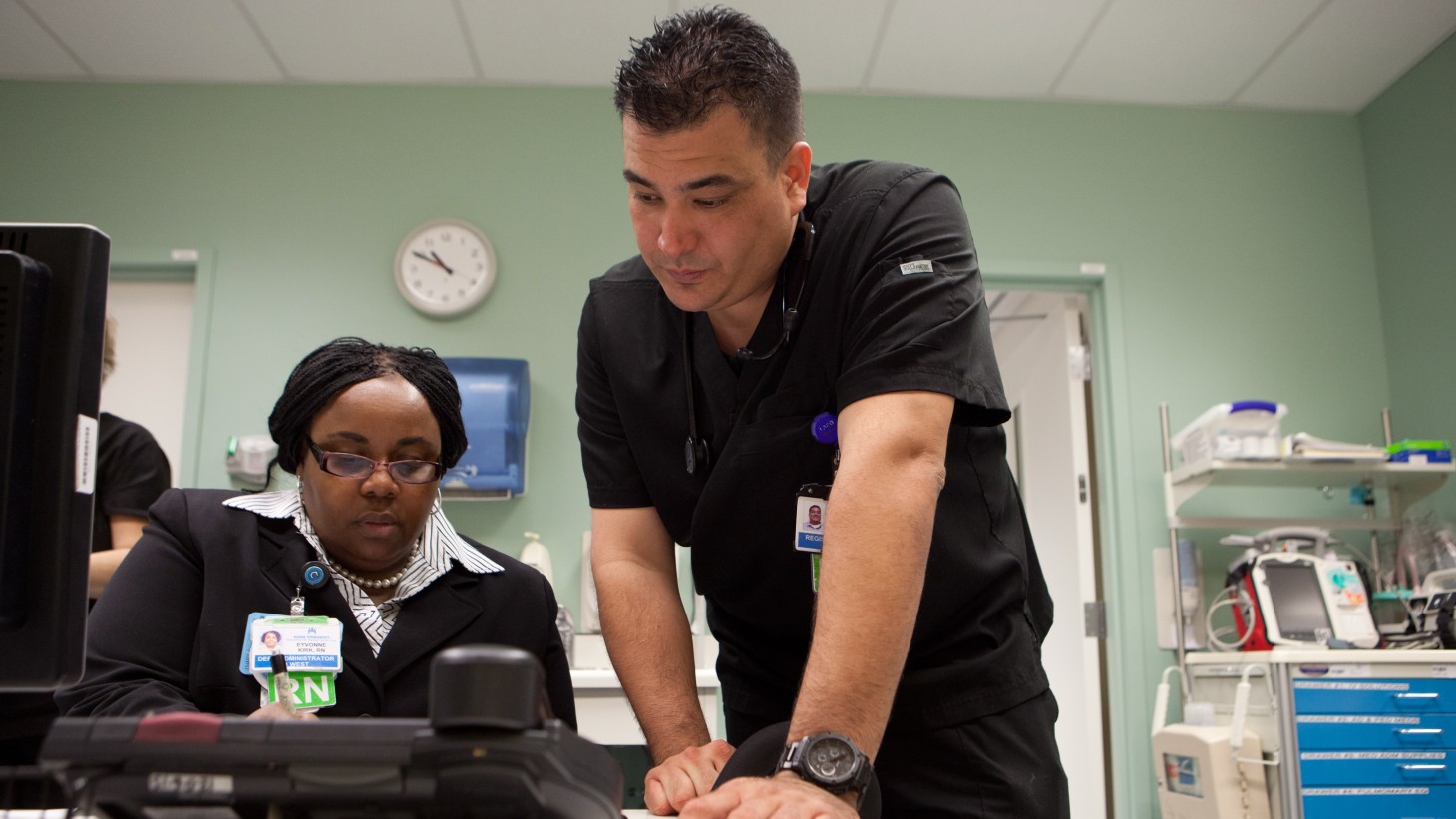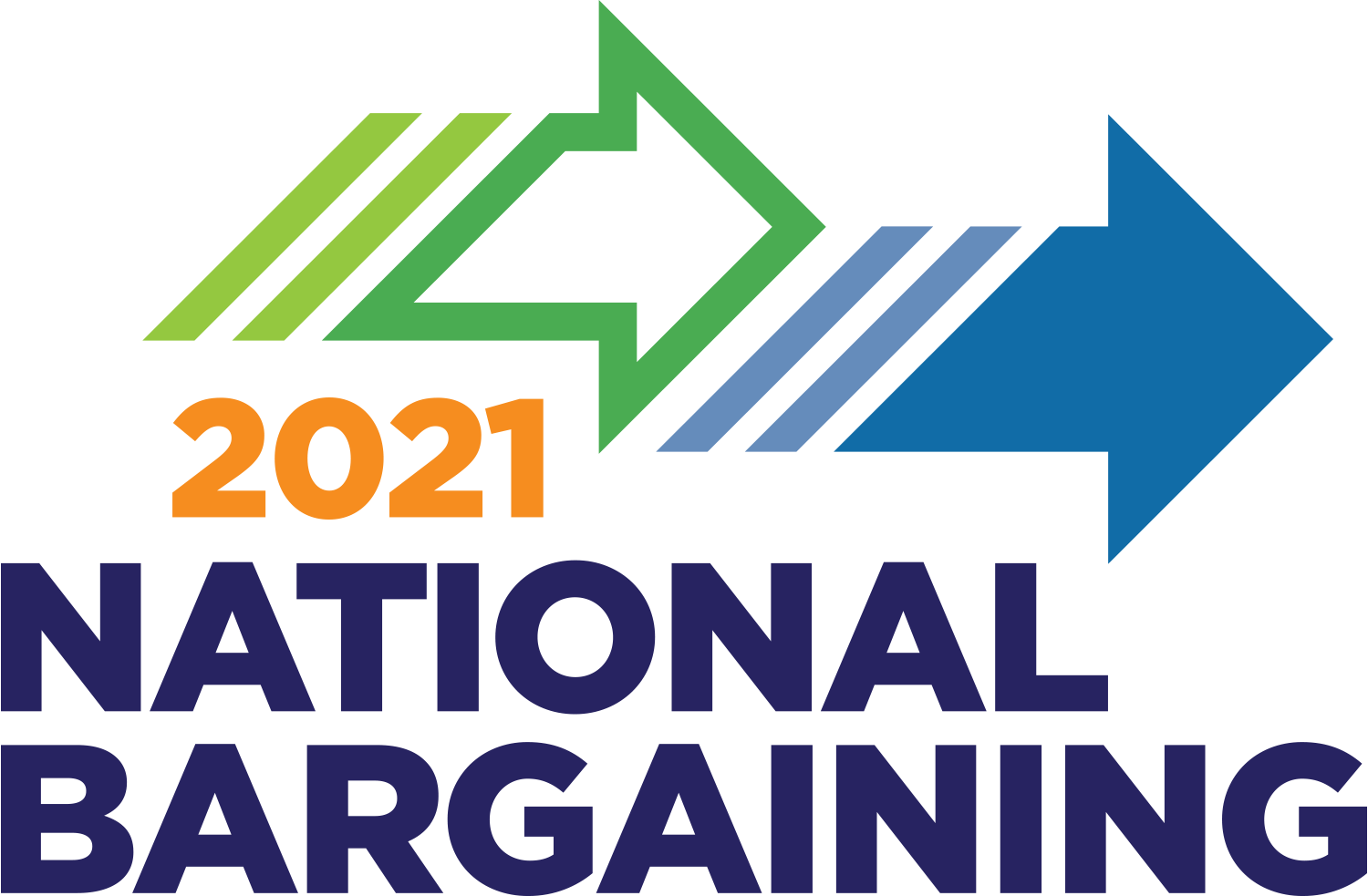HANK Spring 2012
Simple Steps to Superior Service

Eyvonne Kirk, department administrator, with Eric Zambrano, RN, UNAC/UHCP
It's all about common courtesy and communication
Cheryl Kusmits has been a licensed practical nurse for 16 years at Ohio’s Fairlawn Internal Medicine department, a small clinic with a close-knit staff known for its personal service. She loves her job and prides herself on doing it with compassion and a smile.
Kusmits knows all the longtime patients, and they know her. At least, she thought they did. Then she was trained in the service practice known as AIDET—Acknowledge, Introduce, Duration, Explanation and Thank you.
“Until I started saying, ‘My name is Cheryl,’ I didn’t realize, ‘Oh gosh, they see me all the time but I never say my name,’” she says.
When Kusmits introduced herself to a regular patient, he responded he’d been coming there for years and knew her face but had never known her name. It was nice, he said, to finally “meet” her.
Kusmits, who had her doubts about AIDET’s value, was sold on the service training right then.
There’s more to service than being nice
Top-notch service is not just the purview of five-star hotels or, where they still exist, full-service gas stations. These days consumers expect superlative service from their health care providers—and rightly so. No matter how technically superior the care, an inconsiderate or simply indifferent provider spoils the experience. Patients deserve healing, not just fixing.
As a result, providing stellar service to patients and members has never been more important for Kaiser Permanente. Our survival in the competitive health care market rests not only on the quality of care but also the quality of the service we provide to our members. The better the overall experience, the more likely we are to retain current members and gain new ones—ensuring the strength and stability of our model of care, which in turn leads to long-term job security.
“Members’ and patients’ own experiences, or the stories they hear from friends and family, make a huge difference in whether people choose Kaiser Permanente,” says Vickie Cavarlez, an LMP senior labor liaison for public- and private-sector accounts. “As unit-based teams develop, they are making a real difference in the story we can tell.”
The good news is that unit-based teams working to provide our members with the best service possible at every touch point in the system don’t have to start from scratch—they can get a big jump ahead, fast, by taking advantage of KP-endorsed programs with proven track records. Here are the stories of two instances where such programs, AIDET and Nurse Knowledge Exchange Plus—which was pioneered by KP’s Innovation Consultancy—have had dramatic effects.
Could your team be next?
AIDET: More than a surface polish
In 2010, management, physician and union co-leads for all of Ohio’s unit-based teams were trained in the tactic known as AIDET to pump up the region’s service. As a small market that competes in the shadow of the renowned Cleveland Clinic, KP’s Ohio region must go above and beyond in quality of service and care provided.
“We don’t have a physician on every corner. So you have to make it up somewhere, and we make it up in quality and service,” says John Hightower, manager for organizational excellence in Ohio. “It’s part of who we are and who we’re trying to be.”
The region turned to AIDET because of its simplicity. At its core, the training is about communication behaviors and basic courtesy– from acknowledging a patient’s presence with eye contact to explaining that a physician is running late.
Fairlawn Primary Care, where Kusmits is the UBT union co-lead, always had received good service ratings from patients—with scores ranging from 81 percent to 83 percent—but the facility had experienced a small dip in 2010 after it moved offices, dropping to 75 percent. So when nurse manager Paula Hadley, the team’s management co-lead, heard about the AIDET training, she talked with her co-leads—Kusmits and Keith Novak, MD—and volunteered Fairlawn as a pilot site. Initially, reviews were mixed.
“Well, I thought, I’m nice all the time. We’ve always had high scores. I thought, ‘How can I do any better?’” recalls Kusmits, an OPEIU Local 17 member. “But we did. It was kind of amazing when it all happened.”
Fairlawn saw its service scores jump by 10 percentage points within a couple of months after it began using the AIDET behaviors. Office wait scores jumped from 67 percent in January 2011 to 76 percent in August the same year. In the area of staff courtesy and helpfulness, Fairlawn started at 83 percent at the beginning of 2011 and is currently at 89 percent.
The service tool is not a script. It’s not about just being nicer. It’s a set of behaviors, Hightower stresses, that enhances communication and shows respect for the patient.
“And not doing it like a robot,” Hadley says. “It’s genuinely using the behaviors so it’s part of what they are doing every day.”
Of course, there are still those times when an experience isn’t perfect. In such “service recovery” cases, having AIDET under the belt is even more critical. Ohio saw this firsthand at the start of 2012, when it reduced its extensive outside provider network and redirected patients to Permanente physicians. Suddenly patients who had longstanding relationships with outside primary care physicians had to switch to a Permanente primary care physician.
Going above and beyond in service was never more essential.
“I can only tell you that there are some members who are going to be upset no matter what,” Hadley says. “And how we treat them—even if (we’re not giving them) the answer they want—will make a difference in the outcome.”
The power of a seamless handoff
While AIDET provides a foundation for superior service regardless of location, providing a good care experience at the bedside takes additional skills. In the hospital setting, providing a seamless handoff between revolving shifts of caregivers is critical, as is keeping patients informed, involved and confident in their care. Which is where Nurse Knowledge Exchange Plus comes into play.
Longtime nurse Jennifer Toledo remembers “the old days”—which were really only a few years ago—on her medical-surgical unit at Panorama City Medical Center in Southern California. When the registered nurses would change shifts, the incoming nurses would crowd into a conference room and listen to the charge nurse give a brief report on each of the patients. “And we’d all take notes,” says Toledo, a member of UNAC/UHCP.
The practice never sat well with Toledo. “There was no way to validate what the charge nurse was saying,” she says. “And, there were no patients involved.”
Today, shift change on the fourth floor med-surg units is radically different. Incoming and outgoing nurses pair off in patient rooms for the “Nurse Knowledge Exchange Plus”—a structured, in-depth, in-person handoff that puts the patient at the center. Use of NKE Plus has increased nurse time at the bedside by nearly 19 percent and is improving nurse communication service scores among unit-based teams at Kaiser Permanente hospitals in Southern California.
With NKE Plus, the outgoing nurse introduces the incoming nurse to the patient before going off shift. Together, they review and update the patient’s in-room care board. They go over the plan of care, and make sure the patient understands it and has a chance to provide input. Some units use catchy acronyms—this is Kaiser Permanente, after all—such as HEAL to help nurses remember all the elements they need to review (High-alert medications, Environment, Alarms, Lines and drains).
This strategy “encourages more participation from the patient and gives them the security of knowing that someone is looking after them,” Toledo says. “We all agree on the plan, and we can correct misperceptions right then and there.”
Eric Zambrano, a relatively new nurse, agrees with his more seasoned colleague. “It makes the patients less anxious,” he says. “Patients know the plan for the day. It gives them comfort because they are not wondering what is going to happen next.”
NKE Plus “has catapulted our HCAHPS and nurse communication scores” at Woodland Hills, says Nancy Tankel, the nurse executive there, referring to the federal Hospital Consumer Assessment of Healthcare Providers and Systems survey. In fact, between January 2011 and January 2012, HCAHPS scores on a set of questions measuring the quality of nurse communication jumped from 71 percent strongly positive responses to nearly 82 percent. And the staff is as satisfied as the patients.
“I’ve had one nurse tell me, ‘I can sleep at night,’ ” says Tankel.
Lasting impressions
Ultimately, beyond the critical role stellar service plays in Kaiser Permanente’s survival, providing the best experience we can, for every patient and every member, every time, is simply the right thing to do. It’s core to Kaiser Permanente’s mission.
From the moment our members come into contact with Kaiser Permanente, whether online, by phone or in any of our facilities, our interactions with them build or break their trust and loyalty. Providing for a great care experience goes beyond correct diagnoses and treatments. It means asking ourselves if we are looking someone in the eye; if we are examining whether our protocols and procedures make sense, not just for us, but for the members who have to navigate them; and if we are taking care that the many handoffs we make along the way are clear and seamless for our patients and their families.
“We want to keep our patients,” says Ohio LPN Kusmits. “So we need to make them happy and make them feel like we care. And we do care. We need to make sure they’re aware of that.”
To learn more about AIDET, NKE Plus and other evidence-based practices aimed at improving the experience for patients and members, please visit the National Service Quality website.
